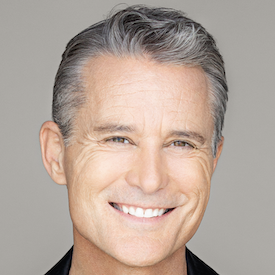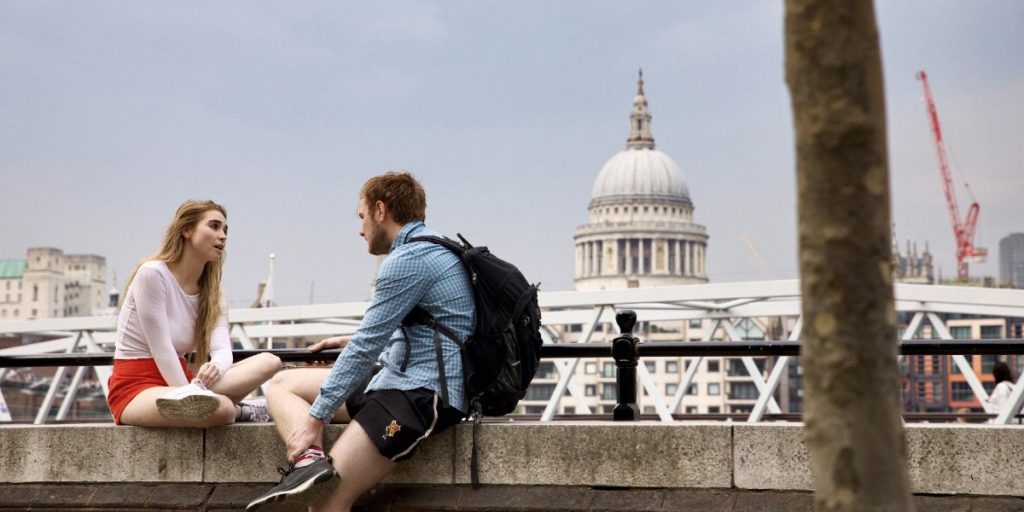Simon Mainwaring is founder & CEO of We First, a strategic consultancy accelerating growth and impact for purpose-driven brands. He’s a member of the Steering Committee of Sustainable Brands and the Forbes Business Council, and he’s a Fellow of the Royal Society of Arts. He was named a Top 50 Keynote Speaker in the World by Real Leaders in 2020, and his company was a Real Leaders’ Top 100 Impact Companies in the US for 2021. His first book, We First, was a New York Times bestseller and named Best Marketing Book of the Year by strategy+business.
Below, Simon shares 5 key insights from his new book, Lead with We: The Business Revolution That Will Save Our Future. Listen to the audio version—read by Simon himself—in the Next Big Idea App.
1. We need to reverse out of the future, rather than build on the past.
All of these issues that are compromising our future—whether it’s the climate emergency, ocean acidification, loss of biodiversity, plastic in our lives, and more—are not sitting statically in the future, waiting for us to arrive. Rather, they’re compounding and hurtling back toward us in the present. Very soon, the self-ordained luxury of choice we currently have as to how far and how fast we change is going to be ripped out of our hands, as businesses of all sizes experience this hockey stick of expectation. Every CEO, company, and employee is going to be forced to articulate whether they’re part of the problem or part of the solution. Why? Because the daily experience of life will be so dramatically impacted by these challenges that everyone will be put on notice.
As we look to the future, there are three viable scenarios. One is that we continue business as usual—the situation gets worse, and we have nothing to do but blame each other and endure the consequences. The second is that half the people do less bad and more good, while the other half remain the same, in which case one undoes the other’s best efforts. And the third is we recognize that we got into this mess together, and we need to solve it together.
2. The virtuous spiral of collectivized purpose.
A key way-finding tool is the idea of the virtuous spiral. This is distinct from the virtuous cycle (doing well by doing good) because the virtuous cycle, in my experience in consulting work, is almost self-limiting. Despite their best intentions, companies work with those stakeholders closest into them—their suppliers, employees, customers, partners—but they don’t reach out and work industry-wide or across sectors to unlock the synergies between them.
In contrast to the virtuous cycle, the virtuous spiral takes the form of an arrow pointing upwards, with a helix wrapping around it—shifting from a “me focus” to a “we focus.” Each of the key levels are very important. The first level is me, my choice to lead. Then there is the leader inside a company, then the culture of that company, then the community of that company, then the societal level, and above that, at the top, the transcendent practice of business.
“The collectivized purpose of business helps us live, work, and grow together in new ways that restore and protect the natural and social systems on which all of our futures depend.”
In addition to the virtuous spiral, there is the collectivized purpose, which is distinct from the individual purpose of many companies. The collectivized purpose of business helps us live, work, and grow together in new ways that restore and protect the natural and social systems on which all of our futures depend. That’s the overarching purpose of business at large, but within that, each company has a purpose that’s distinct and authentic to them.
3. The interconnected levels of the Lead with We virtuous spiral.
As mentioned, there is a series of levels, and while each is important, it’s the cumulative effect that is the key focus. And that first level is me as an individual, as a stakeholder in our future, choosing to show up and do something differently. As we’ve heard from the UN and the COP 26 event, we’re at a code-red-for-humanity moment. We can also see from the Lancet Planetary Health Report that 56 percent of young people around the world believe that humanity is doomed. We are on notice. There is nowhere to hide. The stakes could not be higher.
The second level is leaders, and that could be the CEO or founder, or anyone inside a company that chooses to assume a leadership role. In the virtuous spiral, a company sets an example and others follow. A great exemplar is Walmart, the largest retailer in the world, which declared its ambition to be the first regenerative company in the world. They are now walking that talk with Project Gigaton, a commitment to work with suppliers around the world to take a gigaton of carbon or greenhouse gas emissions out of its supply chain.
Above the leader is the culture level, where a company has defined its purpose and role in the world. At this level, a company wants to engage and co-create its impact with internal stakeholders. A powerful example of that is what Deloitte is doing—one of the world’s largest consulting firms has chosen to educate its 330,000 employees about the climate crisis so they can better serve their clients.
Above the culture level is community. People often think of this as marketing, engaging with your customers or consumers. But I think of it as community architecture—you are building a community that can drive a movement that will scale change. A great example is IKEA, the affordable furniture maker, that in Europe and the U.S. now allows you to bring back IKEA furniture that you no longer want to create a circular economy in its supply chain. At the same time, it’s also selling renewable energy to its customers in Europe so that households can become climate positive. Suddenly the brand becomes a platform through which their customers can not only feel good about what they buy, but can also make themselves more responsible holistically.
“Beyond the societal level is the transcendent level of business, where you transcend me, the leader, the company culture, its community, and society at large, and we restore that symbiotic relationship between humanity and the natural world.”
And then above that community level, we have society. This is when brands, companies, and coalitions take on large social and cultural issues: same-sex marriage, women’s empowerment, gun control, voting rights. A great example is one of the largest CPG companies in the world, Proctor & Gamble, which took on arguably the most complex and sensitive issue: racial discrimination. With their campaign The Look, they addressed the tension and dissonance between people of color and multicultural background and white people, really addressing a societal issue and going to the root cause while also providing a systemic solution through the programs they put in place.
Then finally, beyond the societal level is the transcendent level of business, where you transcend me, the leader, the company culture, its community, and society at large, and we restore that symbiotic relationship between humanity and the natural world. A great example is the company Bolt Threads, which produces an alternative to leather by bio-fabricating a product called Milo out of mycelium. This allows us to take leather out of the fashion industry or the auto industry, and moderate the impact of industrial farming and the tragic cost of animals’ lives.
The larger point here is that the virtuous spiral of collectivized purpose is focused on pulling all of those different stakeholders, all of those complimentary efforts through and up the spiral, so you not only compound your impact, but the benefits flow back down the spiral to all the stakeholders as well.
4. Lead with We in practice.
One of the great challenges for anyone seeking to drive large-scale consumer behavior change or stakeholder engagement is the need to be simple, universal, and versatile at the same time. Research has exposed that a lot of the language in the do-good or social change space—whether it’s sustainable development goals, B corps, social, governance metrics, et cetera—in all of those cases, many stakeholders, consumers, and even employees struggle to understand what those metrics mean. This begs the question: How do we empower everyone, and especially consumers who are making daily choices, to be more mindful of what they’re doing? As well as the entrepreneurs and the C-suite executives who are putting those products in their hand?
In every situation, wherever you are in the world, no matter the size of your company or wherever you sit inside that company, ask yourself in the context of any decision: How do I, A) choose to lead, B) choose to do it with as many stakeholders as possible, and C) in service to the largest we, and the planet? How can I Lead with We? That can be applied at a local community level, at a societal level, a national level, or taking on issues that are pervasive around the world.
“One of the great challenges for anyone seeking to drive large-scale consumer behavior change or stakeholder engagement is the need to be simple, universal, and versatile at the same time.”
5. The radical rebirth of business.
It is truly miraculous what is going on right now, as we remember our innate connection to each other as a human family and to the natural world in which we live. I’m incredibly optimistic, and I want to give you ten reasons to feel the same way. I’ll start with the letter O and we’ll go through “optimistic”:
- O – Older mindsets are rapidly giving way to a new, values-driven approach to business. We see this with BlackRock, the largest money management firm in the world, the Business Round Table, B Corp CEOs, and heads of state at COP26 and the World Economic Forum.
- P – Proliferation of coordinated climate solutions with extensive resources and vast networks around the world, all forging previously unimaginable alliances.
- T – Technologies that provide exponential solutions, like blockchain, AI, and robotics.
- I – Inspiration from the legions of younger, purpose-driven entrepreneurs.
- M – Market forces that are increasingly rewarding purposeful business.
- I – Investors that are redirecting capital to accelerate that shift. There are more young companies satisfying the appetite for good-for-you, good-for-the-planet products. The more capital flows their way, the more young companies will inspire legacy brands to change, and this will become a self-fulfilling prophecy. Market forces will take on a life of their own.
- S – Survival instincts are kicking in. Globally, we’ve been forced during COVID to appreciate how fragile life is and how we, as a species, don’t want to go out of business.
- T – Trust in our innate goodness as human beings, and our profound, undeniable, chemically-hardwired connection to the natural world.
- I – Innovation is being enabled that works with nature rather than against it.
- C – COVID-19, which has been the most tragic, but also most powerful, wake-up call to the world that what we are doing right now isn’t working.
I see this time as a miraculous rebirth of business—appropriately painful, but ushering in the dawn of an era in which we are going to work with the natural world rather than against it. When we do that, nature will dazzle us with its innate regenerative capacity and inspire us to fall in love with the Earth all over again. We can meet these challenges, but only if we Lead with We.
To listen to the audio version read by author Simon Mainwaring, download the Next Big Idea App today:































